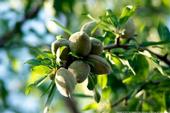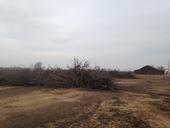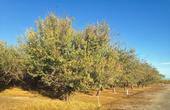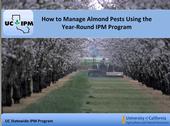
California produces more than 80 percent of the world's commercial almonds. Popularity of the nuts has spurred almond acreage in the state to expand from 510,000 acres in 2000 to roughly 890,000 acres in 2015, according to the USDA National Agricultural Statistics Service. California's Global Warming Solutions Act of 2006, which requires statewide reductions in greenhouse gas emissions, as well as the growing interest among consumers and food companies in the carbon footprint of food products, prompted some University of California scientists to examine how almond production affects the...
- Author: Jeannette E. Warnert

When almond orchards are about 25 years old, farmers must pull out the trees and plant new ones to maintain quality and yield. Typically, the old trees are pushed out and burned or ground up and hauled to a co-generation plant. However, UC Cooperative Extension advisor Brent Holtz believes there may be a better way.
Holtz has been pioneer in ag burn alternatives throughout his 26-year-career with UCCE, and going back still further on his family almond farm near Modesto. Beginning in the early 1990s, Holtz and his father experimented with chipping almond prunings instead of burning them, long before air quality regulations required wide implementation of the practice.
When...
- Author: Jeannette E. Warnert

The dragon sleeping underneath Central Valley almond orchards is yawning and stretching its legs. The dragon is salinity, says UC Cooperative Extension farm advisor David Doll. “You don't notice it until it's too late, and that's when we have a problem,” he said.
Saline accumulation in the orchard soil profile is a recurring headache. But it becomes more acute during droughts, when farmers use more groundwater – which is generally more saline than surface water – or their surface water supply is more saline than normal.
Salinity accumulates in the soil when the tree is growing quickly and almonds are developing throughout spring and summer. When water...
- Author: Aubrey White

Beginning in November, a free, drought-focused soil nutrient management series for farmers will be hosted online by the University of California Sustainable Agriculture Research & Education Program (UC SAREP), FarmsReach and Sustainable Conservation.
“Farmers and ranchers have to continually adapt their management of soil nutrients to changing conditions,” said Aubrey White, UC SAREP's communication coordinator. “Adaptation during this extreme drought presents a new challenge for growers and researchers alike. This forum dedicated to the issues farmers will face next season is an opportunity to share resources, research and...
- Author: Cheryl Reynolds

Spring is here, almonds are blooming beautifully and farmers have not a care in the world. Actually, even though no crop-damaging insects or diseases may be present at the moment, the UC Integrated Pest Management program advises farmers to manage pests year round.
Not sure what you should be doing? UC IPM has just published an online video outlining the year-round IPM program.
How to Manage Almond Pests Using the Year-Round IPM Program is a narrated how–to guide for growers, PCAs, and others who work in almonds, showing what needs to be done throughout the season to stay on top of pest problems.
Going back and forth between the year-round...



